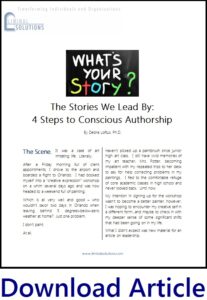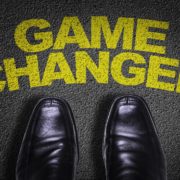The Stories We Lead By: 4 Steps to Conscious Authorship
 The Scene. It was a case of art imitating life. Literally.
The Scene. It was a case of art imitating life. Literally.
After a Friday morning full of client appointments, I drove to the airport and boarded a flight to Orlando. I had booked myself into a “creative expression” workshop on a whim several days ago and was now headed to a weekend full of painting.
Which is all very well and good – who wouldn’t savor two days in Orlando when leaving behind 5 degrees-below-zero weather at home? Just one problem.
I don’t paint.
At all.
Haven’t picked up a paintbrush since junior high art class. I still have vivid memories of my art teacher, Mrs. Potter, becoming impatient with my repeated trips to her desk to ask for help correcting problems in my paintings. I fled to the comfortable refuge of core academic classes in high school and never looked back. Until now.
My intention in signing up for the workshop wasn’t to become a better painter, however. I was hoping to encounter my creative self in a different form…and maybe to check in with my deeper sense of some significant shifts that had been going on in my life.
What I didn’t expect was new material for an article on leadership.
The Framing. The workshop I’d chosen was perfect for my set of intentions. Designed around a philosophy of creativity as a process of receiving rather than of producing, the pre-program literature eased my fears about my lack of artistic skill.
I arrived late the first evening, thanks to the typical O’Hare-based flight delay. Having missed the first 20 minutes of welcomes and introduction to the process, I quickly took a seat and listened as the lead facilitator finished outlining the ground rules. “One of the last ground rules,” he said, “is no commentary. I know many of you will feel like providing supportive comments as you look at others’ work but you are here for your own process. Even though your motivation may be positive, think about the impact of telling someone what you see in their work. You may have just boxed them into your frame of reference. So no comments on each other’s work.”
I felt relieved by that direction. I was being invited to focus on my own experience, not tune into what I could provide to others. What a gift for someone in the helping profession!
The facilitator continued: “Last, when you feel you are done with a painting, you should call me or my co-facilitator over before you take it down. We will want to do some processing with you.” This last ground rule was not unexpected. The literature had explained that the facilitators were there to sometimes ask deeper questions, to encourage the participants to push beyond their perceived limits.
The Painting. Next we were put to work. Thirty-something individual work stations had been set up around three long tables holding tantalizing arrays of water-based paints. I found my spot, smocked up and pulled a paintbrush from the supply we’d been given. Then I waited to see what would emerge.
I didn’t have to wait long. Relaxing into the silent reverie created by a room full of people all turning within, I chose the first color that appealed to me and put brush to paper. The time flew.
My first painting surprised me. It contained some personal imagery from recent scenes in my life and several words. “Yes,” “No,” “Maybe so,” and “Maybe not” appeared, repeatedly. (It struck me later than I’d fallen only a few answers short of approximating a Magic 8 Ball®.) After channeling my personal muse onto paper for an hour or more, I felt I had taken this painting as far as I could. I called over the lead facilitator.
He looked at my work, commenting that the painted words all seemed to be answers to something. “What is the question?” he asked, looking at me intently. I hadn’t really thought about that but the answer rose immediately to the surface. “How to live now, I think,” as I went on to explain some of the changes going on in my life that begged that question.
“What is your narrative about that, about how to live, I wonder?” he offered.
Bingo.
The Artist Behind the Painting. He was speaking my language. Influenced by the work of Dan McAdams, Peter Senge, and others, I often look at the stories my leader clients tell me and ponder the underlying self-narrative from which they are emanating. And the nature of the narrator behind it.
As we live out our lives, we constantly create self-narratives and participate in collective narratives about the nature of life itself. “I’m doing this because…” or “Have you met the new manager? She’s (fill in the adjectives of your choice). I think she will work (fill in adverbs of your choice).” The stories we tell ourselves help us to make sense of external events, of each other, and of ourselves. The stories we hear from others guide, inform and shape us, particularly during our formative years. Without them, we would bounce from one seemingly random moment to another, like that little silver ball in a pinball machine…or the answers in a Magic 8 Ball®.
Our role as makers of meaning through the narratives we create is profoundly important and fundamentally human. From the ancients who would gather around a fire to pass along verbal histories of their tribes to leaders who gather their people in a meeting room to discuss the road forward, we live richly storied lives.
Yet we need to be vigilant, awake to our acts of authorship. Otherwise, we may become unwittingly caught up in a specific narrative that doesn’t ultimately serve us or those we lead. We can become attached to what that narrative represents to us emotionally or intellectually, losing sight of our immense power as conscious creators.
Robert Hargrove makes a useful distinction between “rut stories” – stories that emphasize our powerlessness or victimhood and keep us stuck – and “river stories” – stories that compel us to transform and create movement. Ideally, our narratives connect with our intentions, values, hopes, and commitments…as individuals and as leaders.
Leadership as Art. I see the power of narratives every day as I work with various coaching clients. I also observe it as I interact in various parts of a larger client organization. Invisible threads of individual and collective meaning are strung across the interpersonal landscape like spider webs. Stories are spun that magnify, accelerate, or undermine the “official” narrative, a reminder of the power of human systems.
Some leaders succeed partially because of their ability to be master creators of narratives that guide, inspire, and challenge in a desired direction. I’ve seen other leaders puzzled and even failing from the effects of a collective narrative that has spun out of control.
I personally worked for a leader who, in the midst of multiple, energy-zapping corporate downsizings, was able to engage the imagination of the team I belonged to by suggesting through her words and deeds that we were going to be pioneers of a radical change in business model. Instead of victims, she told us we were “paradigm busters” who could contribute to the larger profession with which we all identified by figuring out different ways to deliver service within our constrained environment. To this day, I still feel a quiet sense of pride when I think back on all that we accomplished together.
This type of leadership impact goes well beyond the mechanics of being a good storyteller; this is narrative creation as a leadership art. The art of meaning making.
Paint by Numbers. Like any artistic process, some individuals are naturally better at meaning-making than others. For the rest of us, several practices can be followed to hone our “conscious narrative creation” skills.
- Cultivating Awareness: For regular readers of my blogs, this first step will not be new. And there’s a good reason for that: most behavioral change comes from paying attention, from focus, as a place to begin. So, start by noticing the narratives you create on your own or participate in with others. Sounds simple, right? Think again.
The narratives I’m talking about here aren’t the mundane stories you tell about what you did over the weekend or the latest gossip about your boss (although those may qualify – read on); rather, I’m addressing the narratives you put together to bring meaning to raw information, to transform a volume of inputs into a meaningful output, or to connect otherwise unconnected events. It’s the larger story that contains many smaller stories.
For example, the workshop facilitator helped me with this awareness by asking me to reflect on the similarities among the words I had put in my first painting. He invited me to check in with my internal stories about my life as well as to form a narrative with him about them. Even before that interpersonal act of meaning-making, however, I was noticing the creative impulse to put those words up, and I felt curious about what they meant. I had tried my best to suspend my internal storytelling, as the process literature had asked me to, but I certainly noticed the pull into doing so.
Once you start paying attention, I think you will be amazed. We are meaning-making machines – through our constant internal monologue and in interactions with others.
- Noticing Content: Once you begin noticing the ubiquity of your narratives, it’s helpful to reflect on the nature of the content. What patterns or themes emerge as you do?
One building block skill that can help here is to separate fact from interpretation (the story). For example, it is fact that I had painted those words in black and red paint on the sheet of paper. Anything more being made out of that (e.g. I did it tentatively, the red was used for words that meant more to me than those in black, those words must be answers to something) was meaning-making. In the facilitator’s interpretation, I had painted all “answer-type words.” He made meaning for me by providing that narrative structure. And it worked for me – I followed it.
Once you have identified some themes, notice the feeling tone that comes with them. For instance, do they feel positive or negative? Affirming or diminishing?
Further, what purpose might those themes and feeling tones serve? Do they align with your intentions, values, and goals you hold for yourself or your organization? Do they speak of problems or possibilities? This step is similar to the analysis of river versus rut stories that I mentioned earlier.
- Enlisting Others: Tap into those around you for help with the noticing. They are often the consumers of your meaning-making attempts, after all. Ask them: “what similarities do you notice, if any, in the questions and comments I tend to make about (fill in the blank: other people’s behavior, my own behavior, new things that happen, the past, the future)?” In addition, pay attention to others’ acts of meaning-making. Again, it can be helpful to practice parsing the actual facts from the meaning-making as people talk to you (but you might want to keep this parsing to yourself or it could get kind of annoying).
Ultimately, what you’re doing here is strengthening the observational skills of your “author self,” the part of you that stands behind all the meaning-making you’ve been more or less consciously doing. Without getting too esoteric, your author self doesn’t live in the stories you’ve created or the themes that have emerged; it lives behind them. Your meaning-making serves as a mirror for a deeper conversation you are having with yourself.
- Conscious Authoring: Building off the strength of your work in the first three steps, you will already have deepened your ability to spot the right moments to consciously create meaning. So now the task is to stay alert for those moments – even to plan for them.
When are those moments likely to be? The moments in which you sense you, your team, or your organization is at a key fork in the road, an inflection point. Strategic discussions are a fabulous example of this type of moment, a moment for leaders to consciously create narrative. A study of strategic planning processes that was written up in the Sloan Management Review found that “strategy making was about constructing new narratives that tie together interpretations of the past, present and future” rather than “the sterile or precise analytical process that both scholars and executives might have hoped it would be.” The authors go on to provide a series of questions to use in creating such a narrative.
Other great moments of conscious authorship present themselves when recent events seem to be keeping you and everyone else in permanent white water, without a deeper understanding of either the cause, the implications of continuing to operate like that, and/or the desired outcome. Consider offering a meaningful interpretation of the events that helps people transcend their own frustration or piece of things to see the larger purpose or value that is being served. The personal story I shared earlier, about the leader who helped me and others become “paradigm busters” instead of victims, provides a great example of this kind of conscious authorship.
A third kind of moment that benefits from conscious authorship is when you sense an evolving narrative in yourself or others that just doesn’t feel right or seem headed in a useful direction. I often counsel leadership clients to “get out ahead” of developing narratives in their organizations that aren’t aligned with their leadership or organizational goals and values. Typically, you’ll hear of these developing narratives through back channels. While it’s important to understand what the existence of those narratives has to tell you about what is important to your employees or their state of mind and heart, it’s also important to engage in what some experts in this space call “re-authoring” so an alternative narrative is available to them.
The Finishing Touch. I did two more paintings in that workshop. The process guidelines urged us to begin each painting as a fresh experience and I thought I did. But my author self was hard at work.
In standing back to look at the full series of three paintings I had created by the end of day two, I saw that each of the additional paintings advanced the same narrative, despite radically different imagery. In debriefing with the facilitators, they sensed the same. Rather than complete my third day of painting, I told them that I would miss it. Instead, I sat outside my hotel with a journal and an iced tea, deepening the conversation with myself that the paintings had begun. Then I typed this blog on the plane ride home, hoping to expand my experience into a shared act of meaning-making.
Our lives as individuals and leaders (assigned and emergent) are lived out against the rich backdrop of the narratives we form to make sense of them. As such, I believe we can all benefit from staying alert to that process, aware of our author selves, and make the most of the moments that would benefit from conscious authorship. Those moments invite us to pause, drop down, and connect, either to the deeper story we’ve been creating – and whether it still serves us – or the need for a new one to emerge.
I don’t always spot those moments in my own life, of course. But I now see the “whim” that led me to sign up for a painting workshop (egads!) as my author self at work, seeking a channel for expression.
That’s my story. And I’m sticking with it.











